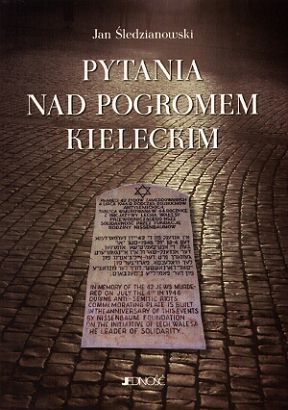Kielce Pogrom Inconvenient Facts Sledzianowski

Pytania Nad Pogromem Kieleckim, by Jan Sledzianowski. 1998
Kielce Plot Thickens: Agent Provocateurs in Action. Long-Term Death Threats Against the Onetime “Kidnapped Boy”. Greatly Exaggerated Participants and Onlookers (Surprise)
QUESTIONS ABOUT THE KIELCE POGROM is the title of this Polish-language work. The author, Jan Sledzianowski, is a Catholic priest who has been studying the Kielce Pogrom for decades.
HENRYK BLASZCZYK, THE ONETIME “KIDNAPPED” BOY, LONG INTIMIDATED INTO SILENCE
In an interview with the author, Henryk Blaszczyk reported that he was ordered to tell others that he had been kidnapped by a Jew. For instance, a member of the Communist security forces (U. B., or BEZPIEKA) told him (and his parents) that they would die, “just like the Jews” if any of them so much as hinted that he was never at any Jews. (p. 22). In addition, he was repeatedly threatened with death if he ever discussed the events at Kielce. Such threats were repeated to him, in person, as recently as 1996 (p. 11) (shortly before the publication of this book), which was years after the fall of Communism in Poland. He also reported that, as an adult, he had never discussed the Pogrom with his parents, even at home, out of fear. His father died in 1965. There was a revival of interest in the Kielce Pogrom at about the time of Solidarity, and Henryk Blaszczyk was asked about it. His mother, who eventually died in 1982, told him never to talk about Kielce “or he will die”. (p. 26).
JUDGE ANDRZEJ JANKOWSKI: AGENT PROVOCATEURS IN ACTION AT KIELCE
The author, in 1998, interviewed Andrzej Jankowski, the judge who had investigated the Kielce Pogrom soon after its occurrence, and who had presided at the trial of the Kielce Pogrom defendants. Jankowski (p. 97) reported that the actual crowd at Planty Street never exceeded 300 people, of whom 90% were gapers. A large fraction had been youth and children, who had been on vacation at the time, and who had been drawn to the site by the shouts. According to Jankowski, about 10% of the crowd consisted of provocateurs who attempted to incite the onlookers against the Jews. There were about 20-30 of them in the early stages of the Pogrom.
So much for the Communist-propaganda myth (most recently repeated by the aptly-named neo-Stalinist Jan T. Gross) that tens of thousands of Poles were involved in the Kielce Pogrom! Fr. Sledzianowski notes that the 300, or even 350, is not even 1% of Kielce’s population. (p. 112). Even if all of them took action against Jews, and they certainly did not, this would not even be a moral indictment of Kielce Poles, let alone a moral indictment of ALL Poles, as Elie Wiesel would have it be. (p. 111).
EARLY DISCERNMENT: KIELCE WAS NOT WHAT THE MEDIA MADE IT OUT TO BE
A group of 15 influential Poles and Jews signed a declaration on July 7, 1946, in New York. The signees included the Jews Henryk Landau and famous Skamander poet Jan Lechon. The statement expressed the signees’ “deepest conviction” that the Kielce Pogrom was a provocation staged by the Communist police. (pp. 147-148).
To see a series of truncated reviews in a Category click on that Category:
- All reviews
- Anti-Christian Tendencies
- Anti-Polish Trends
- Censorship on Poles and Jews
- Communization of Poland
- Cultural Marxism
- German Guilt Dilution
- Holocaust Industry
- Interwar Polish-Jewish Relations
- Jewish Collaboration
- Jewish Economic Dominance
- Jews Antagonize Poland
- Jews Not Faultless
- Jews' Holocaust Dominates
- Jews' Holocaust Non-Special
- Nazi Crimes and Communist Crimes Were Equal
- Opinion-Forming Anti-Polonism
- Pogrom Mongering
- Poland in World War II
- Polish Jew-Rescue Ingratitude
- Polish Nationalism
- Polish Non-Complicity
- Polish-Ukrainian Relations
- Polokaust
- Premodern Poland
- Recent Polish-Jewish Relations
- The Decadent West
- The Jew as Other
- Understanding Nazi Germany
- Why Jews a "Problem"
- Zydokomuna